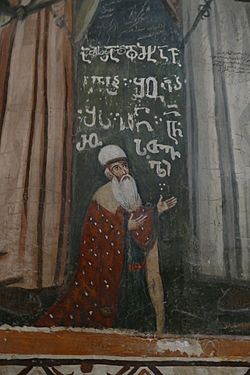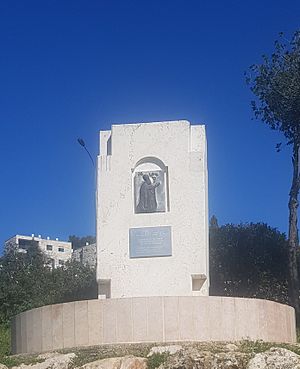Shota Rustaveli facts for kids
Quick facts for kids
Shota Rustaveli
შოთა რუსთაველი |
|
|---|---|

Fresco of Rustaveli in the Monastery of the Cross
|
|
| Born | Rustavi, Meskheti Kingdom of Georgia |
| Died | Jerusalem |
| Resting place | Monastery of the Cross Jerusalem (undisclosed) |
| Pen name | Rustveli Meskhian poet |
| Occupation | poet, thinker, statesman, prince, treasurer |
| Language | Middle Georgian |
| Nationality | Georgian |
| Citizenship | Kingdom of Georgia |
| Alma mater | Gelati academy Ikalto academy Academy in Byzantine Empire |
| Period | Reign of Queen Tamar Georgian Golden Age |
| Genre | poetry, national epic |
| Notable works | The Knight in the Panther's Skin |
Shota Rustaveli (Georgian: შოთა რუსთაველი) was a famous Georgian poet from the Middle Ages. He lived around the years 1160 to 1220. People often just called him Rustaveli.
He is known as one of the most important poets of Georgia's "Golden Age." This was a time when Georgian culture and art were very strong. Rustaveli wrote The Knight in the Panther's Skin, which is a very important national poem for Georgia.
Contents
About Shota Rustaveli
We don't know many details about Shota Rustaveli from his own time. He was likely born between 1160 and 1165. His poem gives us a hint about who he was. He called himself "a certain Rustveli."
"Rustveli" means "from Rustavi." This was a place in the southern Georgian region of Meskheti. His home village was in what is now the Aspindza Municipality. It is not the same as the modern city of Rustavi.
Rustaveli's Life and Work
Later writers from the 1400s to 1700s tell us more about him. They mostly agree that his name was Shota Rustaveli. This name is also found on a painting and a document in a Georgian monastery. This monastery is called the Monastery of the Cross in Jerusalem.
A Georgian traveler named Timote Gabashvili saw the painting in 1757. Georgian experts found it again in 1960. The document from Jerusalem says Shota helped pay for the monastery. It also calls him a "high treasurer."
This matches a popular story that Rustaveli was a minister for Queen Tamar. She was a very powerful queen in Georgia. The story says he retired to the monastery when he was older.
Rustaveli probably studied at famous Georgian schools. These included the Gelati and Ikalto academies. He might have also studied in "Greece," meaning the Byzantine Empire.
He wrote his main poem between the 1180s and the early 1200s. Most likely, it was finished around 1205-1207. Rustaveli knew the Persian language very well. This helped him read and enjoy Persian poetry. He might have even written some Persian poems himself.
The Knight in the Panther's Skin
The Knight in the Panther's Skin is a long, heroic poem. It is very important to Georgian culture. It has been translated into many different languages.
The poem was first printed in 1712. This happened in Tbilisi, the capital city of Georgia. Old copies of the poem are very special.
Old Copies of the Poem
Two pages of the poem from the 1500s are kept in Tbilisi. They are at the Institute of Manuscripts of Georgia. Some lines from the 1300s are also there. Most other copies of the poem are from the 1600s.
Rustaveli's Painting in Jerusalem

The only known painting of Shota Rustaveli from his own time is in Jerusalem. It is on a wall inside the church of the Monastery of the Cross. The painting is at the bottom of two larger pictures of saints. It has a Georgian message next to it.
Sadly, someone damaged the painting in June 2004. They scratched out Rustaveli's face and part of his name. Georgia officially complained to Israel about this damage. Luckily, the painting and the message have been fixed.
Rustaveli's Lasting Impact
Shota Rustaveli is still honored in many ways today. The highest award in Georgia for art and literature is named after him. It is called the Shota Rustaveli State Prize.
Tbilisi, the capital city, has a main street called Rustaveli Avenue. You can also find the Rustaveli Theatre there. Other places named after him include an institute, an airport, and a metro station.
International Recognition
On September 3, 2001, Israel and Georgia worked together. They made special postage stamps to honor Shota Rustaveli. The Israeli stamp showed the poet with Hebrew writing.
Streets in other countries are also named after Rustaveli. You can find them in Tashkent, Uzbekistan, and in Ukrainian cities like Kyiv, Lviv, and Ternopil. There is also a street in Gyumri, Armenia. A path in Jerusalem that leads to the Monastery of the Cross is also named for him.
A Georgian composer named Tamara Vakhvakhishvili used Rustaveli's poetry in her music. She created a piece for voice and orchestra called Citation.
Mihály Zichy's Art
Mihály Zichy was a Hungarian painter from the 1800s. He became known as a "national painter" in Georgia. This is because he created famous drawings for Rustaveli's poem. These drawings are often used in new editions of the poem. There is a statue and a street in Tbilisi that honor Zichy's work.
See also
 In Spanish: Shota Rustaveli para niños
In Spanish: Shota Rustaveli para niños


